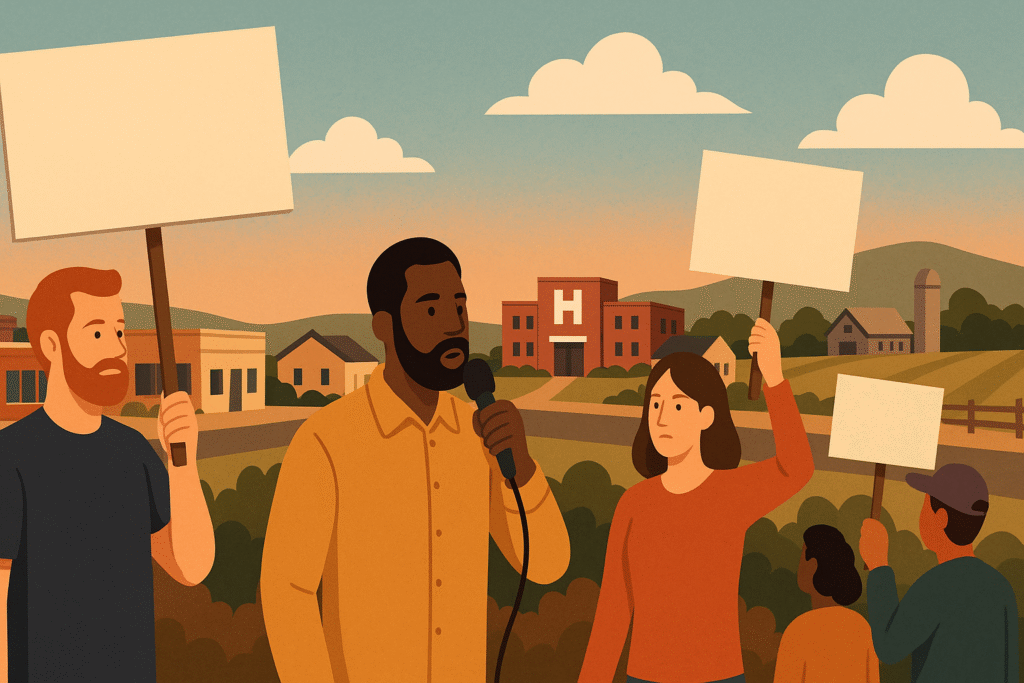Across rural America, Democratic organizers and progressive advocates are identifying a political shift. A controversial tax and spending law passed by the Republican-led Congress in July has sparked widespread discontent, particularly over cuts to Medicaid, food assistance programs, and rural hospital funding. Democratic strategists see this as a pivotal moment to reengage communities that have long supported former President Donald Trump and the Republican Party.
Local Voices Drive New Democratic Strategy
Grassroots organizer Dom Holmes, 28, has spent the past decade working in rural Pennsylvania. He emphasizes that true political engagement in these communities requires more than policy leaflets or campaign rallies—it demands listening.
“People are outraged about the local impact,” Holmes said. “They’re worried about losing essential services. And they want to know who’s responsible.”
Holmes and other activists say rural residents are increasingly receptive to Democratic messaging as they experience the tangible effects of GOP-led policy changes. Local organizers are leading the charge, refusing to wait for national support to mobilize voters.
Matt Hildreth, Executive Director of RuralOrganizing.org, echoed that sentiment. “We don’t tend to wait around. The energy is already happening on the ground.”
Healthcare and Economic Anxiety Intensify
The newly passed spending bill has stirred concern about the future of rural healthcare. With many hospitals already struggling, additional funding cuts could lead to closures, leaving residents with limited access to essential services.
Lily Franklin, a Democratic candidate for Virginia’s House of Delegates in a rural Appalachian district, is witnessing this anxiety firsthand.
“Folks are already driving over an hour to access care,” Franklin said. “Now they’re worried even those facilities might disappear.”
Franklin previously lost her race by only 183 votes, outperforming both President Biden and Vice President Harris in her district. Her grassroots campaign is gaining renewed attention from national political groups aiming to flip competitive rural districts.
GOP Cuts Compound Rural Struggles
According to Hildreth, the law’s cuts are just one piece of a broader pattern of policy decisions that disproportionately harm rural economies. From frozen farm subsidies and tariffs to the removal of clean energy incentives, the cumulative impact is becoming untenable for many communities.
“When you put all these cuts together—Medicaid, SNAP, farm programs—it’s just not sustainable,” Hildreth said. “And I don’t think the White House realizes how hard this is hitting rural America.”
Hildreth’s organization is active in battleground districts across Iowa, Ohio, and Pennsylvania, centering its efforts on empowering local voices to reshape the Democratic brand from the bottom up.
Democrats and Republicans Compete for Rural Messaging
The Democratic National Committee (DNC) has been investing in rural outreach, including billboard campaigns near at-risk hospitals and financial support for state party operations in red states. According to DNC Deputy Executive Director Libby Schneider, “Donald Trump has been disastrous for our rural communities, and the DNC will continue to highlight how Republicans have betrayed these voters.”
Republicans, on the other hand, are doubling down on defending the law. A memo from the National Republican Congressional Committee (NRCC) encourages lawmakers to promote the law’s benefits while branding Democrats as out-of-touch elitists. Although the memo emphasizes support for work requirements in Medicaid, it does not directly address the risk of hospital closures.
From Protest to Political Action
Stephanie Porta, campaign manager for Battleground Alliance PAC, believes this moment is ripe for transformation. Her organization—a coalition of over 30 advocacy groups—has pledged $50 million to flip 35 vulnerable GOP-held districts in 2026.
“We’re seeing real momentum from protests not just in cities, but in rural towns,” Porta said. “Now it’s about channeling that energy into voter education and mobilization.”
Initiatives include school supply giveaways, public demonstrations at airports, and extensive canvassing to inform voters about the bill’s impacts.
Voters Respond to Authentic Engagement
In Virginia, Franklin says voters respond when candidates listen rather than lecture.
“These communities have felt abandoned. No one’s shown up to hear their concerns in years,” she said. “Half the battle is just listening.”
Although Franklin is running for a state legislative seat, she finds that voters often express concern about federal programs such as Medicaid and SNAP. Her campaign highlights how states will be forced to fill financial gaps created by federal cuts—if they can afford to.
National political organizations have taken notice of Franklin’s strong performance in a competitive rural district. But she cautions against using uniform national messages.
“We’ve often relied on lab-tested slogans,” she said. “But people just want to be heard. That’s the secret.”
Conclusion
With Republicans holding the House by a narrow 219–212 margin and four seats vacant, Democrats see an opening to reclaim influence in rural America. For many organizers, this moment is about more than just winning elections—it’s about rebuilding trust in places where voters feel left behind. As national debates play out, the decisive voices may come not from Washington, but from the front porches and farms of America’s small towns.



